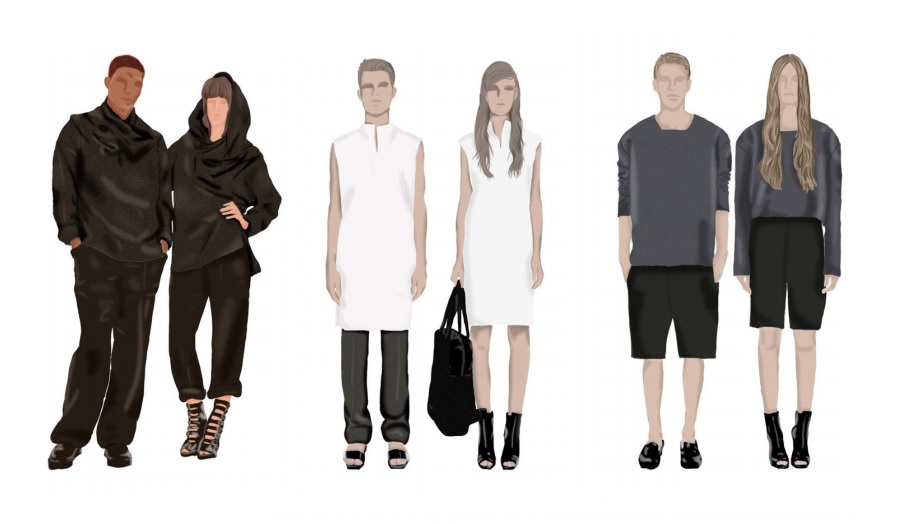Dr Aurore Bardey explores unisex clothing from the perspective of designers and consumers, and its historical context.
Date: 19 October 2020
“Genderless”, “agender”, or “unisex” are just a few of the ways to describe fashion designed to be worn by both males and females, which appears to be growing traction as a trend.
But as Senior Lecturer in Psychology Dr Aurore Bardey, notes, androgyny is nothing new. As far back as King Louis XIV of France, we can observe clothes which take markers of femininity but are designed to fit male bodies; similarly, there is an established history of females being dressed in traditionally male silhouettes such as the suit and tie, most often associated with Marlene Dietrich in the 1930s.
But the lack of a unified definition of what makes clothing “unisex”, argues Dr Bardey in newly published research, leaves room for theoretical discussion and exploration.
“What is considered a feminine dress in one (sub)culture may be a perfectly acceptable way of dressing for males in another or vice versa,” she explains. “It seems that, at its essence, all clothing is unisex. It is rather a culture and its norms that ascribe a gender to an item of clothing and by continually labelling it as thus, reinforce the way it is perceived.”
Along with colleagues Pak Chiu and Judith Achumba-Wollenstein, Dr Bardey designed two studies to assess the psychological processes behind unisex clothing. Study 1 evaluated how fashion designers approach unisex clothing design and their views on consumers; while Study 2 assessed consumers’ perceptions and willingness to wear unisex clothing, and whether the unisex label, and typical markers of femininity and masculinity in clothing, impacted consumer behaviour.
11 Fashion Design graduates from the London College of Fashion were recruited to take part in Study 1. Through a qualitative interview approach, four areas of the designers’ process were explored in developing a unisex dress; mapping stakeholders – identifying all the people involved in the purchase and design of unisex clothing; exploring personas and characteristics of potential consumers; describing the user journey and how consumers would or could interact with the product; and capturing the needs of each stakeholder.
One of the most critical needs for the unisex dress stakeholders was the retailing demand. Participants mentioned the importance of the dress being marketable, trendy, and appealing to a maximum number of consumers. One said, “I need this (unisex) dress to be marketable,” while another agreed that, “it should have a commercial appeal.”
Participants also highlighted the need to incorporate masculine markers in unisex dress design, with one saying “I need a dress to incorporate masculine features because it would be easier psychologically to wear it in public.”
The last need described by participants was the social context and the social understanding of gender. Commenting on the garment, one designer asked “can he even get out of the bedroom?”, signifying the stigma that men may experience when wearing a unisex dress. Another highlighted the need for social acceptability in developing unisex products saying, “we need this dress to be wearable and flattering for society/the individual to accept it.”
In Study 2, 263 potential consumers were divided into two groups; a “unisex” group and a “control” group. Participants were required to look at a picture representing a unisex outfit and rate the gender characteristics of the outfit. For the “unisex” group, the clothing had been labelled as such — the participants had been told they were looking at unisex clothing. In the “control” group, clothing has not been labelled — participants were not told they were looking at unisex outfits. They were also required to specify whether they would wear the clothing and why.
“The results showed a difference in consumers’ willingness to wear some outfits depending on the unisex label,” Dr Bardey explains. “When the outfits were not labelled as unisex, consumers were more willing to wear navy blue long dungarees, a large black tunic/dress, a straight white dress, and a large denim outfit. When outfits were labelled as unisex, consumers were more willing to wear grey suits.
“Our analysis also showed that men were less willing to wear outfits evaluated as feminine, which supports previous research that most consumers tend to dress according to their gender identity.
“Our analysis didn’t show much difference among female consumers. The history of fashion trends can explain this result — it is well known that Coco Chanel’s first female suits are now embedded in our culture.”
Overall, the research showed that designers tend to focus more on understanding the social context of unisex clothing consumers, while consumers are more inclined to prioritise fashion style in choosing clothing. This research emphasises the need for design thinking as well as the need for a better understanding of consumer requirements in fashion marketing.
Read the full article: Aurore Bardey , Judith Achumba-Wöllenstein & Pak Chiu (2020): Exploring the Third Gender in Fashion: From Consumers’ Behavior to Designers’ Approach towards Unisex Clothing, Fashion Practice

